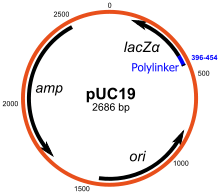pUC19
Like pUC18, pUC19 belongs to a series of cloning vectors genetically engineered in the laboratory of Joachim Messing . These bacterial plasmids are among the most commonly used vectors for cloning in the bacterium Escherichia coli . They are therefore of great importance in biological research and genetic engineering . Their special advantages are their small size, the ability to identify recombinant plasmids by means of blue-white screening and a particularly high number of copies per bacterial cell (so-called high copy number plasmids), so that a large amount of plasmid can be isolated very easily .
properties
Historically, they are derivatives of the pBR322 plasmid. The pUC plasmids use the modified origin of replication or ori for short of the pBR322 plasmid. The ori has been shortened and lacks the coding region for the ROM / ROP protein . By knockout of ROP, the copy number of plasmids ColEI can generally be increased as long as the cultivation temperature at> 30 ° C. In addition, the modified ori has a point mutation G → A at position 112 of RNA II. This results in the increased number of copies of these vectors.
At 2686 bp, they are relatively small and additional DNA fragments can be inserted into them at special restriction enzyme cleavage sites in the multiple cloning sites (MCS, polylinker) . For selection of pUC-positive bacteria following insertion of the plasmid into a suitable bacterial strain ( transforming an existing in the pUC plasmids used) ampicillin - resistant gene (ampR). The transcription of inserted genes in E. coli can be achieved in a targeted manner by inducing the built-in promoter fragment of the lac operon with IPTG . The vector codes for the N-terminal fragment (amino acids 1-5 and 8-60) of β-galactosidase (l acZ ) from E. coli . Codons 6-7 have been replaced by MCS and thus allow blue-white selection. The two pUC plasmids only differ in the inverse orientation of the MCS.
It has a mass of . In its natural, supercoiled state, its gyroscopic radius was determined to be 65.6 nm and its hydrodynamic radius to be 43.6 nm.
The name of the plasmids is derived from the University of California (UC), where these plasmids (p) were constructed.
swell
- ↑ a b C. Yanisch-Perron, J. Vieira, J. Messing: Improved M13 phage cloning vectors and host strains: nucleotide sequences of the M13mp18 and pUC19 vectors. In: Genes. Volume 33, Number 1, 1985, pp. 103-119, PMID 2985470 .
- ↑ J. Vieira, J. Messing: The pUC plasmids, an M13mp7-derived system for insertion mutagenesis and sequencing with synthetic universal primers. In: Genes. Vol. 19, Number 3, October 1982, pp. 259-268, ISSN 0378-1119 . PMID 6295879 .
- ↑ Sue Lin-Chao, Wen-Tsuan Chen, Ten-Tsao Wong: High copy number of the pUC plasmid results from a Rom / Rop-suppressible point mutation in RNA II . In: Molecular Microbiology . tape 6 , no. November 22 , 1992, ISSN 0950-382X , p. 3385-3393 , doi : 10.1111 / j.1365-2958.1992.tb02206.x , PMID 1283002 .
- ↑ C.Helmer-Citterich, M., Anceschi, MM, Banner, DW & Cesareni, G. (1988), Control of ColE1 replication: low affinity specific binding of Rop (Rom) to RNAI and RNAII. The EMBO journal 7 (2), 557-66.
- ↑ Dominic Störkle, Sabrina Duschner, Nils Heimann, Michael Maskos, Manfred Schmidt: Complex Formation of DNA with Oppositely Charged Polyelectrolytes of Different Chain Topology: Cylindrical Brushes and Dendrimers . In: Macromolecules . tape 40 , no. 22 , October 5, 2007, pp. 7998-8006 , doi : 10.1021 / ma0711689 ( acs.org [accessed August 4, 2016]).
See also
- pBR322 (output vector)
Web links
- Sequence of pUC19c
- Information and restriction map of pUC18 and pUC19 ( Memento from February 20, 2009 in the Internet Archive )

